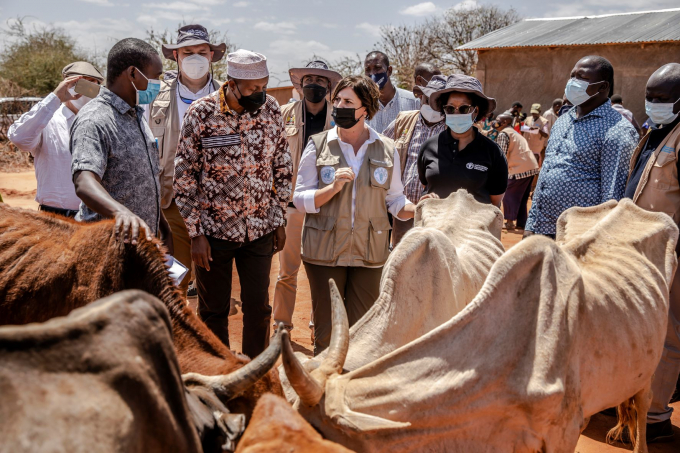November 26, 2025 | 22:24 GMT +7
November 26, 2025 | 22:24 GMT +7
Hotline: 0913.378.918
November 26, 2025 | 22:24 GMT +7
Hotline: 0913.378.918

FAO Deputy Director-General Beth Bechdol visiting Emergency Livestock Supplements distribution Center in Isiolo, Kenya. Photo: FAO
An extended, multi-season drought is driving acute food insecurity in the Horn of Africa, with 12 to 14 million people now at risk as crops continue to wither and animals weaken, the Food and Agriculture Organization of the United Nations (FAO) and partners warned today.
Resource-based conflicts are escalating as competition for water and pasturelands increases, and malnutrition rates are rising in affected areas of Ethiopia, Kenya and Somalia, highlighting the need to sustain the rural livelihoods that underpin peace and food security across the Horn.
At a briefing to international donors in Nairobi, FAO and its partners reported that the food security outlook in the region will be highly dependent on the performance of the upcoming rainy season, with forecasts currently uncertain.
In a worst-case scenario in which the rains completely fail and agricultural-dependent communities do not receive adequate support, the number of highly food insecure people could climb to 15-20 million – with some worst-affected households facing “catastrophic” hunger conditions.
Additional new analysis published on Thursday from the Food Security and Nutrition Analysis Unit (FSNAU) for Somalia, hosted by FAO, shows that in Somalia alone, the number of acutely food insecure people (IPC Phase 3 and 4) is expected to increase from 3.5 to 4.1 million between January and March 2022, if humanitarian assistance is not received on time.
FAO’s Deputy Director-General, Beth Bechdol; Subregional Coordinator for Eastern Africa, David Phiri; and Director of Emergencies and Resilience, Rein Paulsen have just completed a visit to Kenya to raise awareness on the drought and see FAO’s vital response in action, including in Isiolo and Marsabit counties in the north.
“Drought cycles are intensifying and occurring with greater frequency. Immediate humanitarian action to support farmers and herders is needed now,” said Bechdol, after visiting Kenyan communities where goats and cows are dying from lack of water and pasture. “The international community has a narrow window to prevent a major humanitarian catastrophe here,” she said.
“Alarm bells have already been rung – scaled-up action is needed now,” said Phiri. “FAO carried out anticipatory actions during the latter half of 2021 in Ethiopia, Kenya and Somalia to mitigate the impacts of drought on over one million rural people and so far a crisis has been mitigated. But much more is needed as the situation deteriorates and as crisis looms,” he said.
A plan to help rural families cope
Under FAO’s new Horn of Africa Drought Response Plan, $130 million is urgently needed to provide time-critical assistance to highly vulnerable communities in drought-hit regions of the three countries. The plan supports the production of up to 90 million litres of milk and up to 40 000 tonnes of staple food crops in the first part of 2022, putting over one million highly-food insecure people on a safe footing.
For pastoralist families, FAO aims to deliver animal feed and nutritional supplements, provide mobile veterinary health clinics, transport 10 000 litre collapsible water reservoirs to remote areas, and upgrade existing wells to run on solar power.
For farming families, FAO aims to distribute drought-tolerant early-maturing varieties of sorghum, maize, cowpea and other beans and vegetables.
FAO is also carrying out cash transfers and cash-for-work programmes to ensure the most vulnerable can access food.
(FAO.org)

(VAN) A new study reveals how the simultaneous effects of ocean acidification, salinity and loss of oxygen are making the world more fragile.

(VAN) Hopes are growing that the creation of the first 3D turkey gut model could be a turning point in the battle against the virulent blackhead disease.

(VAN) Tyson, America’s biggest meat supplier, plans to shutter one of its largest beef processing plants as the industry continues to struggle with low cattle supplies and political pressure from Washington.

(VAN) New FAO study shows how digital solutions are empowering farmers and fishers to prevent losses and build resilient agrifood systems.

(VAN) Brazil's COP30 presidency pushed through a compromise climate deal on Saturday that would boost finance for poor nations coping with global warming but that omitted any mention of the fossil fuels driving it.

(VAN) Poultry farmers in the UK have been warned that they could face one of the worst winters yet for bird flu.

(VAN) Prices of main-crop paddy have risen sharply, with jasmine rice hitting 16,100 baht per tonne — the highest level in years.